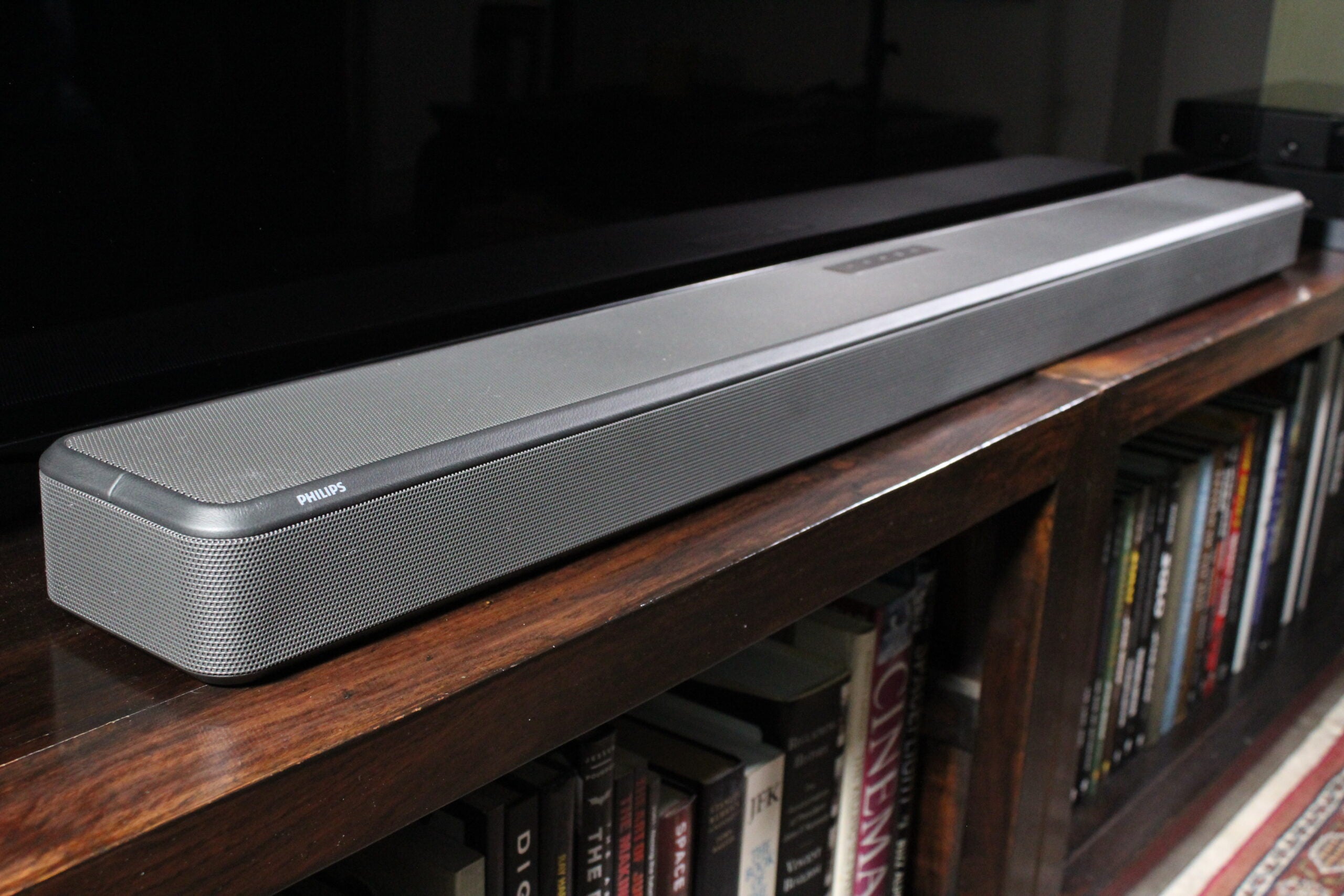Verdict
This accomplished and stylish soundbar delivers incredibly deep bass considering there’s no separate subwoofer, and the soundstage is enjoyably expansive with precisely placed overhead effects. The connectivity is limited, but otherwise this is a convenient and effective audio solution.
Pros
- Expansive front soundstage
- Remarkable bass extension
- Precise overhead effects
- Clear dialogue channel
Cons
- Front-heavy delivery
- No support for 4K/120Hz
Availability
- UKRRP: £799
- USAunavailable
- EuropeRRP: €799
- Canadaunavailable
- Australiaunavailable
Introduction
The Philips Fidelio FB1 is a single-box soundbar that supports Dolby Atmos and uses a pair of built-in woofers to generate deeper bass, despite lacking a separate subwoofer.
It’s not dissimilar to Bowers & Wilkins’ Panorama 3, but Philips hopes the inclusion of DTS:X and Play-Fi, plus a few nice design touches, will help it stand out from the crowd.
Design
- Stylish finish, with ring lights around the upfiring drivers
- Touch-sensitive controls, minimalist remote, and a brace of apps
- Display is behind a metal grille, making it hard to read
The Philips Fidelio FB1 soundbar forms part of the brand’s premium audio range, and boasts an elegant design that certainly looks like a high-end product. The cabinet is fairly large at 1200 x 73 x 120mm (WxHxD), but the sleek styling ensures it doesn’t dominate the space under your TV. It’s also extremely well made, with a robust metal construction that clocks in at a hefty 7.2kg.
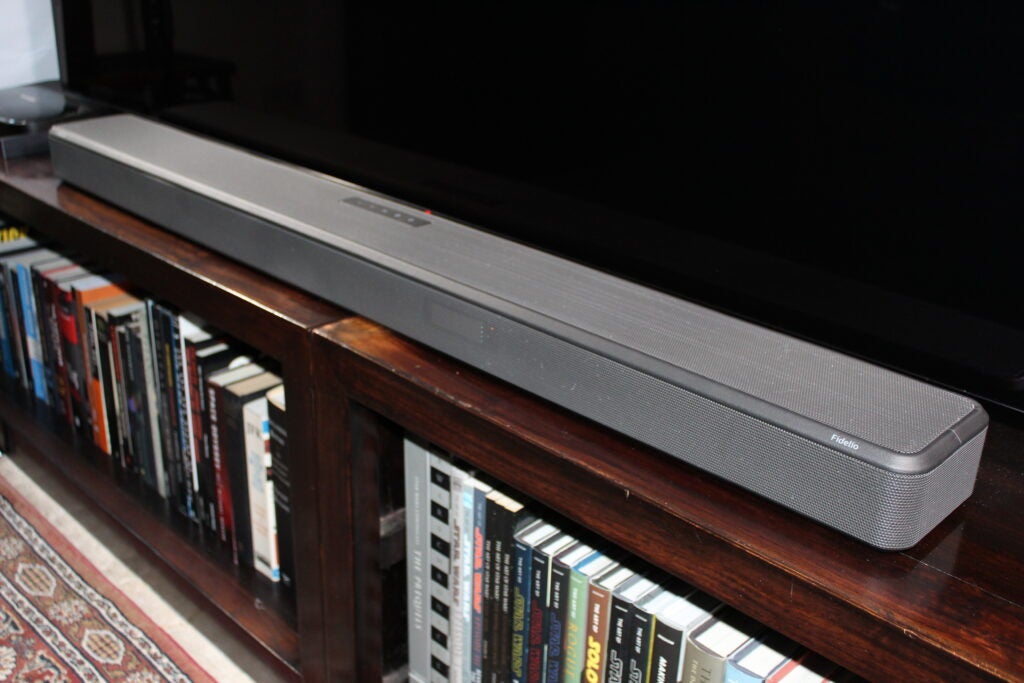
The finish is excellent, with rounded corners on the cabinet and a Muirhead leather trim that separates the top, front, and side panels, lending the soundbar a degree of class. The speakers are located behind mesh metal grilles, as is the display on the front right, although because of this it can be difficult to clearly read at times. You have the option to stand or wall mount the FB1.
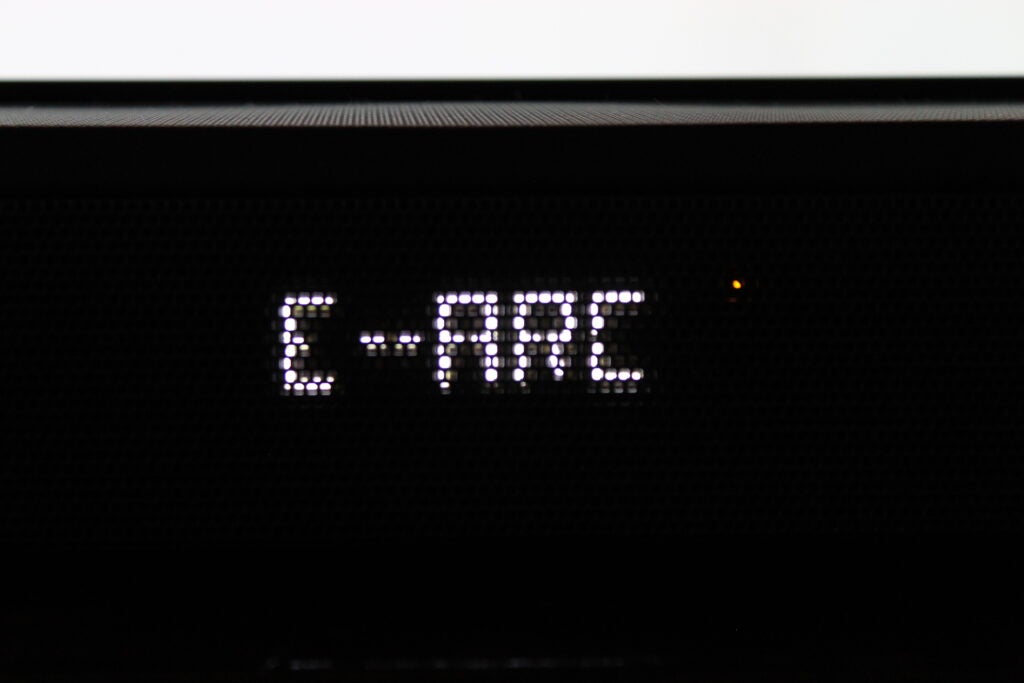
There are ring lights around the upfiring drivers that illuminate when the FB1 is decoding an object-based audio format, and while it looks groovy, you can also turn this feature off if it becomes annoying or distracting. There are some basic touch-sensitive buttons on the top of the cabinet, which you’re unlikely to ever use due to a host of other options.
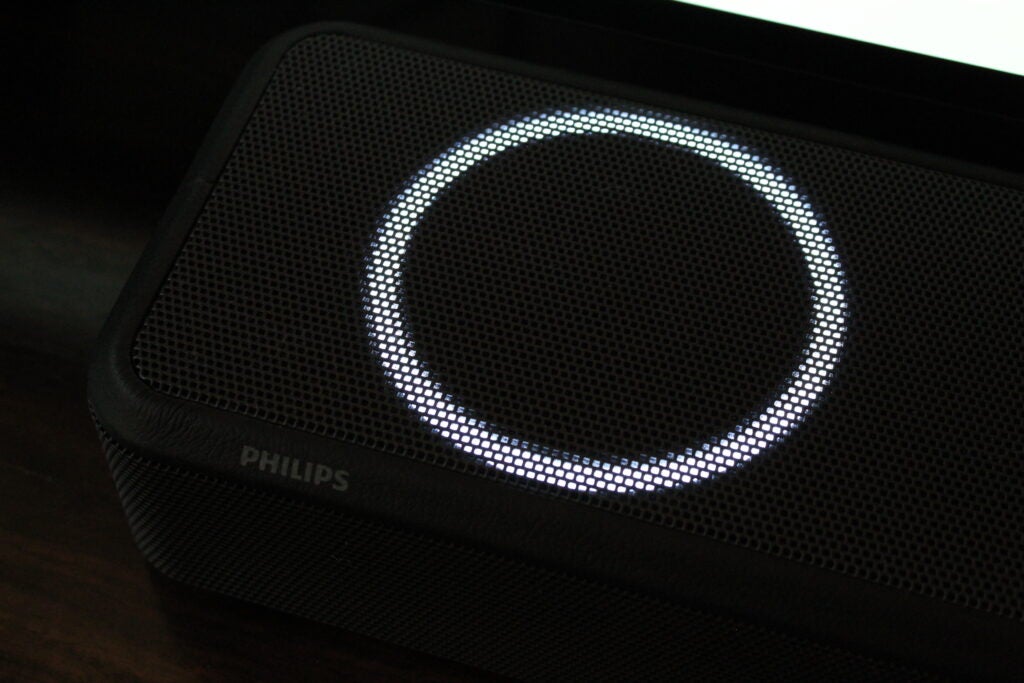
Annoyingly, the included remote is so minimalist that it can be difficult to actually use, with most of the buttons identified using less-than-intuitive icons, and no labels at all for the volume controls. Thankfully there are alternative remote options, including voice control via the FB1’s ability to work with Amazon Alexa and Google Assistant, or even Siri through Apple’s AirPlay 2.
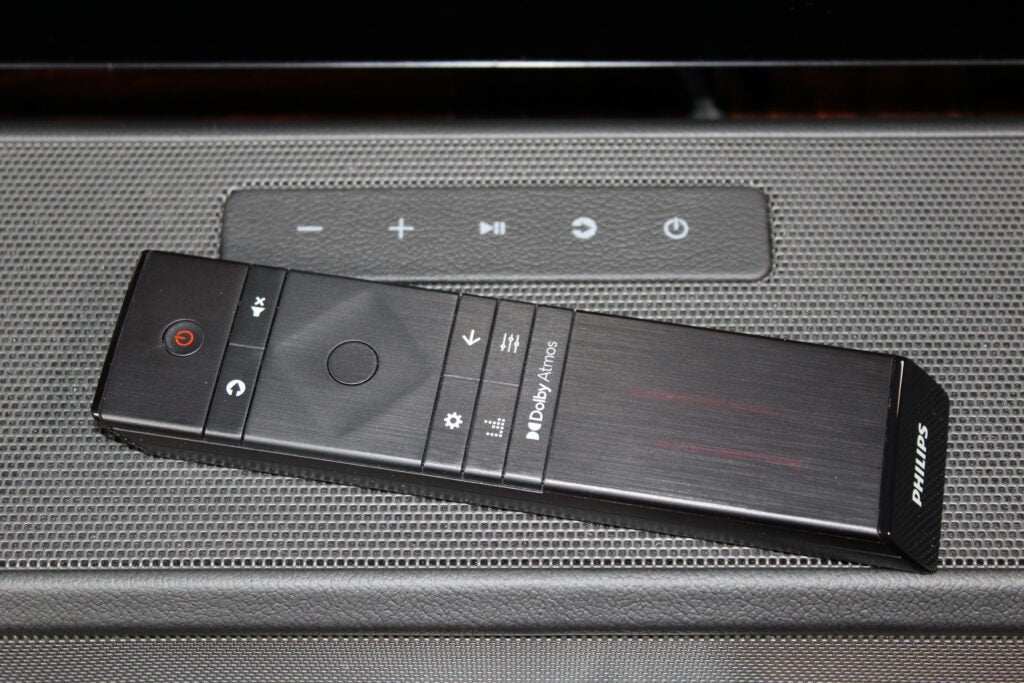
There’s also a brace of control apps: Philips Sound integrates with DTS Play-Fi, adding streaming services like Spotify, Tidal, Amazon Music, Qobuz, Deezer and Internet Radio; while Philips Fine Tune controls the volume, EQ selection, surround modes, and levels for the surround channels. This app makes setup easier, especially compared to using the remote and hard-to-read display.
Features
- 5.1.2-channel speaker layout
- Dolby Atmos, DTS:X and IMAX Enhanced
- Automatic room correction system
- HDMI connection with eARC
- DTS Play-Fi wireless multi-room support
The Philips Fidelio FB1 uses a 5.1.2-channel speaker configuration, with front left, right and centre channels, side-firing width channels, and a pair of up-firing overhead channels. These speakers are full range and comprise a total of 13 drivers and tweeters, including a pair of 3.5in woofers for bass extension down to a remarkable 40Hz.
The entire system is driven by a total of 310W of amplification, with peaks up to 620W when needed, which allows this soundbar to go loud without ever sounding brittle or underpowered. The actual speaker layout is 5.1.2, but Philips claims the FB1 can deliver a virtual 7.1.2-channel experience thanks to psychoacoustic processing that creates the illusion of rear speakers.
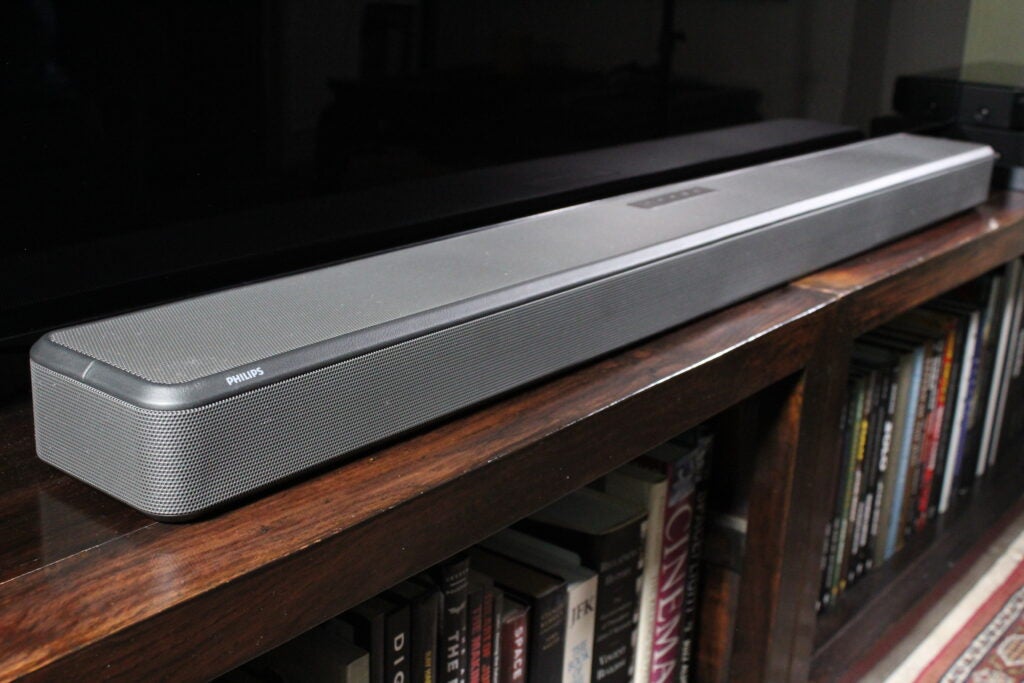
There’s a calibration microphone in the box that connects to the soundbar using a 3.5mm jack, triggering the automated room correction system to start playing a series of test tones. These are measured by the microphone, and the data is used to optimise the overall sound, eliminating the more negative aspects of the room.
The FB1 decodes all three of the main immersive audio formats: Dolby Atmos, DTS:X, and IMAX Enhanced. It also supports DTS Play-Fi, which provides multi-room capabilities and playback of Hi-Res Audio formats, along with the ability to wirelessly add the Fidelio FS1 rear speakers and FW1 subwoofer to create a genuine 7.1.2-channel system.
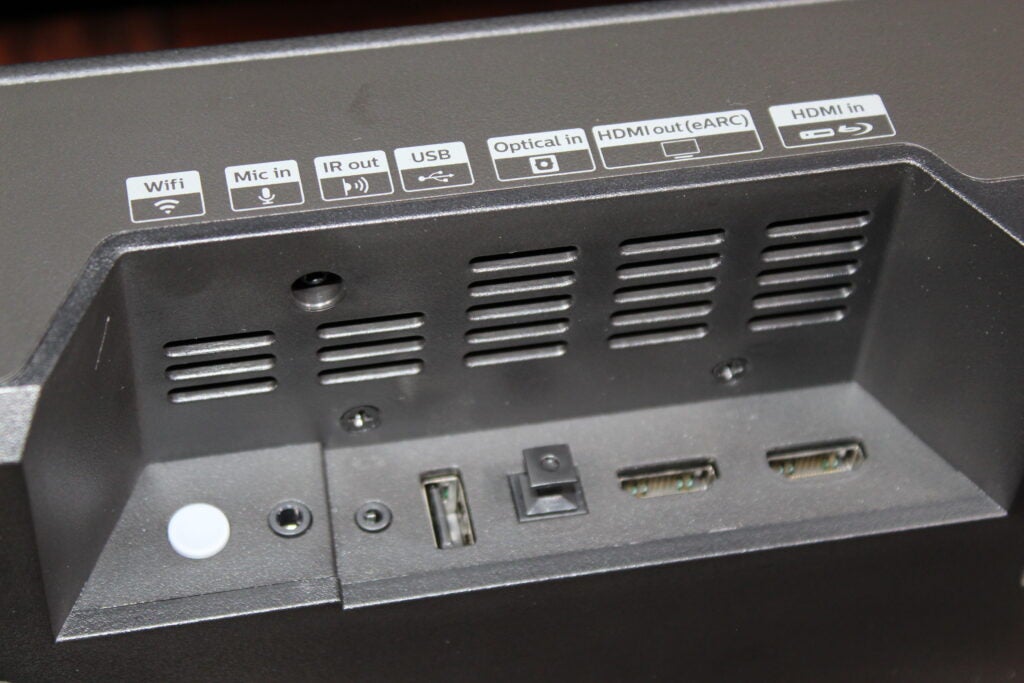
At the rear is an HDMI input, and an output that supports eARC (enhanced audio return channel). Both also pass 4K/60p, and every version of HDR (HDR10, HLG, HDR10+, and Dolby Vision). Surprisingly there’s no passthrough of 4K/120p, VRR (variable refresh rate) or ALLM (auto low latency mode), which will disappoint next-gen gamers.
In terms of other connectivity, there’s an optical digital audio input, and a USB port that supports MP3, WAV, and FLAC files. For wireless connections there’s a choice of dual-band Wi-Fi, Bluetooth 5.0, and Apple AirPlay 2, plus there’s also built-in Chromecast, and Spotify Connect.
Sound Quality
- Effective height channels
- Excellent bass performance
- Expansive front soundstage
- No real surround presence
The Philips Fidelio FB1 might be a single-box soundbar but it manages to produce a soundstage with plenty of width, some well-placed overhead effects, and a surprising amount of bass. As a result, you can partner it with a fairly large screen and enjoy an equally big sound without having to install a subwoofer or any other speakers, thus making it a convenient solution.
However, a degree of management expectation is required, because the FB1 essentially fills the first third of the room with sound, and despite Philips’s claims of surround envelopment, there really isn’t any presence behind me. The effectiveness of the upfiring drivers is also dependant on your ceiling – the flatter and more reflective, the better.
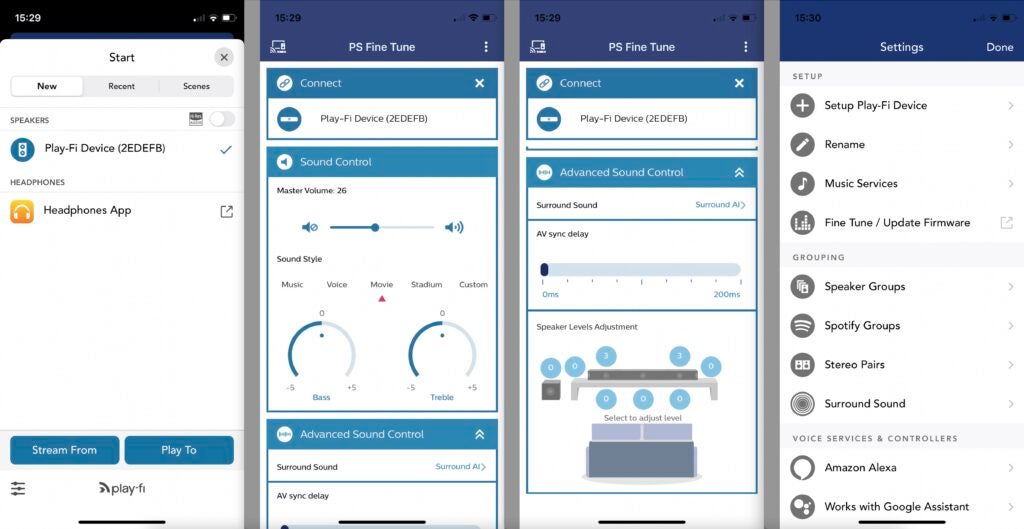
The overall delivery is tight and detailed, with a treble that’s free of congestion, and a midrange that’s clear and well-defined. Philips has tuned the system so there’s a pleasing tonal balance and general cohesion to the soundstage, while the two built-in woofers crossover smoothly with all the other drivers in the cabinet.
The twin woofers produce some really deep bass, suggesting the claims of a frequency response down to 40Hz aren’t mere hyperbole. There’s a swiftness to the transients and a composure that gives any low-end effects a tightness, speed, and depth. I don’t really miss a separate sub, but the FB1 doesn’t disgrace itself, even on a bass-heavy soundtrack like Monster Hunter.
When it comes to Dolby Atmos, DTS:X, and IMAX Enhanced, I find the FB1 handles these object-based soundtracks with poise and skill, creating a three-dimensional presence that spreads out across the ceiling and side walls. The audio effects are picked out and placed with precision, while the steering around the front of the room is seamless.
An immersive Atmos soundtrack like Dune delivers plenty of scale, especially during the flight through the desert storm or when the sandworms show up. There are four levels of Atmos decoding, designed to deliver Minimal, Small, Medium and Big amounts of overhead action. These choices are intended to accommodate different ceiling heights.
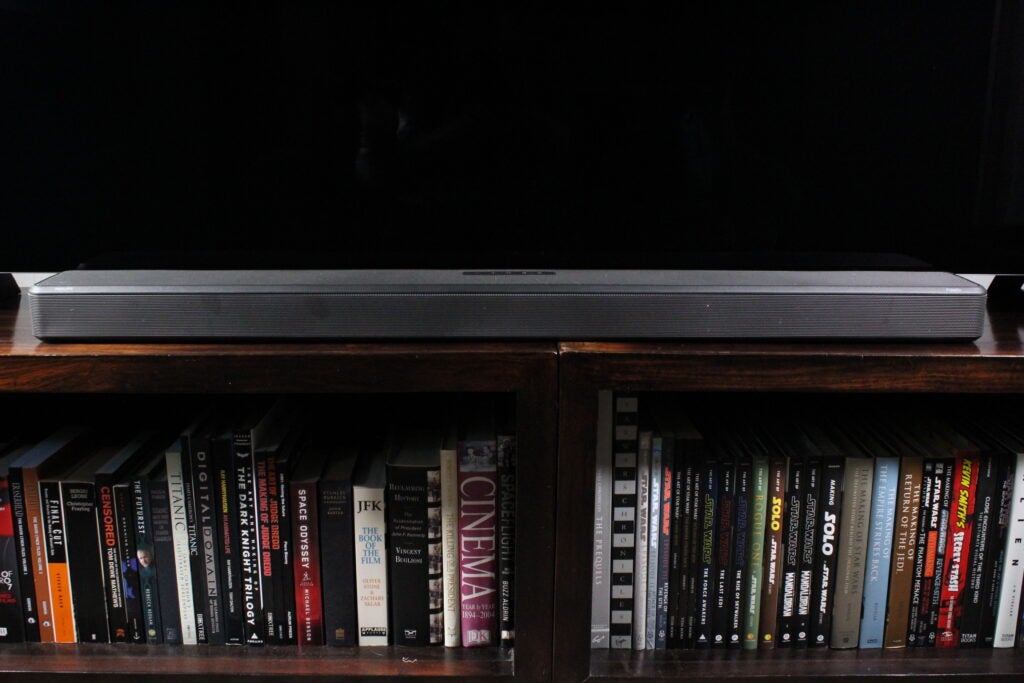
The FB1 is equally impressive when it comes to decoding DTS:X soundtracks, and a film like Atomic Blonde feels suitably visceral, especially during the bone-crunching fight scenes. This soundbar’s low-end capabilities are undoubtedly due to the inclusion of IMAX Enhanced, with the format demanding increased bass extension for effective delivery.
There’s a DTS: Neural X upmixing mode that creates a more immersive experience from non-object-based soundtracks by making use of all available channels. There are also various sound modes, with the Movie preset generally the best option, primarily because the Surround AI setting tends to boost the height/surround effects at the expense of the overall cohesion.
Latest deals
Should you buy it?
You want a soundbar that’s convenient but effective The Fidelio FB1 manages to deliver immersive audio and deep bass from a single box.
You’re a next-gen gamer The lack of full HDMI 2.1 connectivity means no passthrough for features like 4K/120, VRR and ALLM.
Final Thoughts
The Philips Fidelio FB1 is eye-catching and stylish thanks to a premium finish and ring lights around the upfiring drivers, but its big selling point is an ability to deliver detailed sonics, plenty of width and surprisingly deep bass from a single box.
You can enjoy all the main immersive audio formats thanks to some well-placed overhead effects, while dialogue is rendered with clarity. The high quality speakers sound good with both movies and music, producing a delivery that’s clear and focused, if rather front heavy.
Setup is easy thanks to an audio calibration feature, ensuring the FB1 sounds balanced and cohesive regardless of the acoustics of your room. There’s no support for next-gen gaming features, but otherwise you get maximum immersion with the minimum of fuss.
How we test
We test every soundbar we review thoroughly over an extended period of time. We use industry standard tests to compare features properly. We’ll always tell you what we find. We never, ever, accept money to review a product.
Find out more about how we test in our ethics policy.
FAQs
Yes, the Fidelio FB1 supports virtually all the available DTS tracks, from DTS:X to DTS-HD High Resolution Audio and DTS Master Audio. You can passthrough DTS through each of the twin HDMI inputs.
Sustainability
Trusted Reviews’ holds the fact that global warming is not a myth as a core value and will continuously endeavour to help protect our planet from harm in its business practices.
As part of this mission, whenever we review a product we send the company a series of questions to help us gauge and make transparent the impact the device has on the environment.
We currently haven’t received answers to the questions on this product, but will update this page the moment we do. You can see a detailed breakdown of the questions we ask and why in our sustainability info page.
Jargon buster
Dolby Atmos
Dolby Atmos is an object-based audio format. It expands on 5.1 and 7.1 soundtracks by adding overhead channels. Sounds are referred to as “audio objects”, of which there can be up to 128 audio channels, and these ‘objects’ can be accurately positioned within a 3D soundscape. This allows soundtracks that support the technology to place sounds above and around the listener with compatible kit.
DTS:X
DTS:X is an object-based audio format created in 2015 for the home. The premise is similar to Dolby Atmos in that it creates a hemisphere of sound that’s more lifelike and natural in its presentation.
Verdict
This accomplished and stylish soundbar delivers incredibly deep bass considering there’s no separate subwoofer, and the soundstage is enjoyably expansive with precisely placed overhead effects. The connectivity is limited, but otherwise this is a convenient and effective audio solution.
Pros
- Expansive front soundstage
- Remarkable bass extension
- Precise overhead effects
- Clear dialogue channel
Cons
- Front-heavy delivery
- No support for 4K/120Hz
Availability
- UKRRP: £799
- USAunavailable
- EuropeRRP: €799
- Canadaunavailable
- Australiaunavailable
Introduction
The Philips Fidelio FB1 is a single-box soundbar that supports Dolby Atmos and uses a pair of built-in woofers to generate deeper bass, despite lacking a separate subwoofer.
It’s not dissimilar to Bowers & Wilkins’ Panorama 3, but Philips hopes the inclusion of DTS:X and Play-Fi, plus a few nice design touches, will help it stand out from the crowd.
Design
- Stylish finish, with ring lights around the upfiring drivers
- Touch-sensitive controls, minimalist remote, and a brace of apps
- Display is behind a metal grille, making it hard to read
The Philips Fidelio FB1 soundbar forms part of the brand’s premium audio range, and boasts an elegant design that certainly looks like a high-end product. The cabinet is fairly large at 1200 x 73 x 120mm (WxHxD), but the sleek styling ensures it doesn’t dominate the space under your TV. It’s also extremely well made, with a robust metal construction that clocks in at a hefty 7.2kg.

The finish is excellent, with rounded corners on the cabinet and a Muirhead leather trim that separates the top, front, and side panels, lending the soundbar a degree of class. The speakers are located behind mesh metal grilles, as is the display on the front right, although because of this it can be difficult to clearly read at times. You have the option to stand or wall mount the FB1.

There are ring lights around the upfiring drivers that illuminate when the FB1 is decoding an object-based audio format, and while it looks groovy, you can also turn this feature off if it becomes annoying or distracting. There are some basic touch-sensitive buttons on the top of the cabinet, which you’re unlikely to ever use due to a host of other options.

Annoyingly, the included remote is so minimalist that it can be difficult to actually use, with most of the buttons identified using less-than-intuitive icons, and no labels at all for the volume controls. Thankfully there are alternative remote options, including voice control via the FB1’s ability to work with Amazon Alexa and Google Assistant, or even Siri through Apple’s AirPlay 2.

There’s also a brace of control apps: Philips Sound integrates with DTS Play-Fi, adding streaming services like Spotify, Tidal, Amazon Music, Qobuz, Deezer and Internet Radio; while Philips Fine Tune controls the volume, EQ selection, surround modes, and levels for the surround channels. This app makes setup easier, especially compared to using the remote and hard-to-read display.
Features
- 5.1.2-channel speaker layout
- Dolby Atmos, DTS:X and IMAX Enhanced
- Automatic room correction system
- HDMI connection with eARC
- DTS Play-Fi wireless multi-room support
The Philips Fidelio FB1 uses a 5.1.2-channel speaker configuration, with front left, right and centre channels, side-firing width channels, and a pair of up-firing overhead channels. These speakers are full range and comprise a total of 13 drivers and tweeters, including a pair of 3.5in woofers for bass extension down to a remarkable 40Hz.
The entire system is driven by a total of 310W of amplification, with peaks up to 620W when needed, which allows this soundbar to go loud without ever sounding brittle or underpowered. The actual speaker layout is 5.1.2, but Philips claims the FB1 can deliver a virtual 7.1.2-channel experience thanks to psychoacoustic processing that creates the illusion of rear speakers.

There’s a calibration microphone in the box that connects to the soundbar using a 3.5mm jack, triggering the automated room correction system to start playing a series of test tones. These are measured by the microphone, and the data is used to optimise the overall sound, eliminating the more negative aspects of the room.
The FB1 decodes all three of the main immersive audio formats: Dolby Atmos, DTS:X, and IMAX Enhanced. It also supports DTS Play-Fi, which provides multi-room capabilities and playback of Hi-Res Audio formats, along with the ability to wirelessly add the Fidelio FS1 rear speakers and FW1 subwoofer to create a genuine 7.1.2-channel system.

At the rear is an HDMI input, and an output that supports eARC (enhanced audio return channel). Both also pass 4K/60p, and every version of HDR (HDR10, HLG, HDR10+, and Dolby Vision). Surprisingly there’s no passthrough of 4K/120p, VRR (variable refresh rate) or ALLM (auto low latency mode), which will disappoint next-gen gamers.
In terms of other connectivity, there’s an optical digital audio input, and a USB port that supports MP3, WAV, and FLAC files. For wireless connections there’s a choice of dual-band Wi-Fi, Bluetooth 5.0, and Apple AirPlay 2, plus there’s also built-in Chromecast, and Spotify Connect.
Sound Quality
- Effective height channels
- Excellent bass performance
- Expansive front soundstage
- No real surround presence
The Philips Fidelio FB1 might be a single-box soundbar but it manages to produce a soundstage with plenty of width, some well-placed overhead effects, and a surprising amount of bass. As a result, you can partner it with a fairly large screen and enjoy an equally big sound without having to install a subwoofer or any other speakers, thus making it a convenient solution.
However, a degree of management expectation is required, because the FB1 essentially fills the first third of the room with sound, and despite Philips’s claims of surround envelopment, there really isn’t any presence behind me. The effectiveness of the upfiring drivers is also dependant on your ceiling – the flatter and more reflective, the better.

The overall delivery is tight and detailed, with a treble that’s free of congestion, and a midrange that’s clear and well-defined. Philips has tuned the system so there’s a pleasing tonal balance and general cohesion to the soundstage, while the two built-in woofers crossover smoothly with all the other drivers in the cabinet.
The twin woofers produce some really deep bass, suggesting the claims of a frequency response down to 40Hz aren’t mere hyperbole. There’s a swiftness to the transients and a composure that gives any low-end effects a tightness, speed, and depth. I don’t really miss a separate sub, but the FB1 doesn’t disgrace itself, even on a bass-heavy soundtrack like Monster Hunter.
When it comes to Dolby Atmos, DTS:X, and IMAX Enhanced, I find the FB1 handles these object-based soundtracks with poise and skill, creating a three-dimensional presence that spreads out across the ceiling and side walls. The audio effects are picked out and placed with precision, while the steering around the front of the room is seamless.
An immersive Atmos soundtrack like Dune delivers plenty of scale, especially during the flight through the desert storm or when the sandworms show up. There are four levels of Atmos decoding, designed to deliver Minimal, Small, Medium and Big amounts of overhead action. These choices are intended to accommodate different ceiling heights.

The FB1 is equally impressive when it comes to decoding DTS:X soundtracks, and a film like Atomic Blonde feels suitably visceral, especially during the bone-crunching fight scenes. This soundbar’s low-end capabilities are undoubtedly due to the inclusion of IMAX Enhanced, with the format demanding increased bass extension for effective delivery.
There’s a DTS: Neural X upmixing mode that creates a more immersive experience from non-object-based soundtracks by making use of all available channels. There are also various sound modes, with the Movie preset generally the best option, primarily because the Surround AI setting tends to boost the height/surround effects at the expense of the overall cohesion.
Latest deals
Should you buy it?
You want a soundbar that’s convenient but effective The Fidelio FB1 manages to deliver immersive audio and deep bass from a single box.
You’re a next-gen gamer The lack of full HDMI 2.1 connectivity means no passthrough for features like 4K/120, VRR and ALLM.
Final Thoughts
The Philips Fidelio FB1 is eye-catching and stylish thanks to a premium finish and ring lights around the upfiring drivers, but its big selling point is an ability to deliver detailed sonics, plenty of width and surprisingly deep bass from a single box.
You can enjoy all the main immersive audio formats thanks to some well-placed overhead effects, while dialogue is rendered with clarity. The high quality speakers sound good with both movies and music, producing a delivery that’s clear and focused, if rather front heavy.
Setup is easy thanks to an audio calibration feature, ensuring the FB1 sounds balanced and cohesive regardless of the acoustics of your room. There’s no support for next-gen gaming features, but otherwise you get maximum immersion with the minimum of fuss.
How we test
We test every soundbar we review thoroughly over an extended period of time. We use industry standard tests to compare features properly. We’ll always tell you what we find. We never, ever, accept money to review a product.
Find out more about how we test in our ethics policy.
FAQs
Yes, the Fidelio FB1 supports virtually all the available DTS tracks, from DTS:X to DTS-HD High Resolution Audio and DTS Master Audio. You can passthrough DTS through each of the twin HDMI inputs.
Sustainability
Trusted Reviews’ holds the fact that global warming is not a myth as a core value and will continuously endeavour to help protect our planet from harm in its business practices.
As part of this mission, whenever we review a product we send the company a series of questions to help us gauge and make transparent the impact the device has on the environment.
We currently haven’t received answers to the questions on this product, but will update this page the moment we do. You can see a detailed breakdown of the questions we ask and why in our sustainability info page.
Jargon buster
Dolby Atmos
Dolby Atmos is an object-based audio format. It expands on 5.1 and 7.1 soundtracks by adding overhead channels. Sounds are referred to as “audio objects”, of which there can be up to 128 audio channels, and these ‘objects’ can be accurately positioned within a 3D soundscape. This allows soundtracks that support the technology to place sounds above and around the listener with compatible kit.
DTS:X
DTS:X is an object-based audio format created in 2015 for the home. The premise is similar to Dolby Atmos in that it creates a hemisphere of sound that’s more lifelike and natural in its presentation.



















